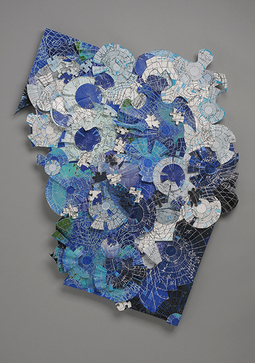 Northern Water 8
Northern Water 8
TERRAIN by Phyllis Ewen presents sculptural drawings that explore the fast-changing phenomenon of global warming, highlighting the effects of rising waters and parched earth. Each piece consists of dissected maps, charts and photographs, with handmade jigsaw fragments that further articulate the three-dimensional surface and ripple throughout the composition, alluding to the crumbling world, while coated in either aquatic or earth tones.
Darkness gradually rises in Ewen’s 8-piece series titled Northern Waters (2013) which begins with swirls of white and blue ice caps that gradually transform into greens and deep blues as the series progresses, signifying the replacement of ice with new vegetation. The graph and symbols seen in nautical charts surface throughout as fragments that first insinuate a particular direction. However as the compositions erode and alter in color, the paths seen in these aerial views gradually fade away and blur, a metaphor for an exacerbating problem. An ominous conclusion appears in Northern Waters 7 (2013) showing black and white fading together over the layers of this three-dimensional drawing. And in Northern Waters 8 the dark sea colors break the boundaries of the rectangle.
Ewen changes the scale in Plague (Rio Grande) (2013), in which the sand is filled with writhing lizards and the air with ochre locusts. Parched earth defines Disierto (Colorado River) (2013). Ewen crosshatches paper with beige and red hues to capture the geological reality of arid land: sand, heat, sweltering rocks with little to no water. However a more even symbiosis appears in three drawings from the Waterways series. Suite Champlain (2013) presents three long fragments of water that flow down across green and white surfaces. The artist captures more depth and ocean volume in Tidal Fugue (2013) where land is submerged over unexpected waves of water.
TERRAIN reflects the surface of what we see when looking at the earth from extreme distances and paradoxically asks us to become submerged in close observation. Phyllis Ewen tests the viewer by reducing the shifting, physical nature of topography into a series of constructions offering up a solid response to recent environmental events such as hurricanes, tornados, earthquakes and the resulting damage. Together the artist’s different combination of motifs, hues and topographic surfaces presents an undulating portrait of environmental evolution. [or devolution?]
Jill Conner is an art critic based in New York City and the curates AS | Artists Studios.
Darkness gradually rises in Ewen’s 8-piece series titled Northern Waters (2013) which begins with swirls of white and blue ice caps that gradually transform into greens and deep blues as the series progresses, signifying the replacement of ice with new vegetation. The graph and symbols seen in nautical charts surface throughout as fragments that first insinuate a particular direction. However as the compositions erode and alter in color, the paths seen in these aerial views gradually fade away and blur, a metaphor for an exacerbating problem. An ominous conclusion appears in Northern Waters 7 (2013) showing black and white fading together over the layers of this three-dimensional drawing. And in Northern Waters 8 the dark sea colors break the boundaries of the rectangle.
Ewen changes the scale in Plague (Rio Grande) (2013), in which the sand is filled with writhing lizards and the air with ochre locusts. Parched earth defines Disierto (Colorado River) (2013). Ewen crosshatches paper with beige and red hues to capture the geological reality of arid land: sand, heat, sweltering rocks with little to no water. However a more even symbiosis appears in three drawings from the Waterways series. Suite Champlain (2013) presents three long fragments of water that flow down across green and white surfaces. The artist captures more depth and ocean volume in Tidal Fugue (2013) where land is submerged over unexpected waves of water.
TERRAIN reflects the surface of what we see when looking at the earth from extreme distances and paradoxically asks us to become submerged in close observation. Phyllis Ewen tests the viewer by reducing the shifting, physical nature of topography into a series of constructions offering up a solid response to recent environmental events such as hurricanes, tornados, earthquakes and the resulting damage. Together the artist’s different combination of motifs, hues and topographic surfaces presents an undulating portrait of environmental evolution. [or devolution?]
Jill Conner is an art critic based in New York City and the curates AS | Artists Studios.